Druid Circle of the Land Build and Guide
The Druid is one of the most complex classes, but if you are looking for a more simple caster than, say, a Sorcerer or a Wizard, then the Circle of the Land subclass will be a great choice for you.
In tune with nature, like every Druid is, you will have plenty of options to help your party and over time you will become the strand of roots that holds your team together.
Thanks to your knowledge of spells and shapeshifting you will be using them throughout your journey in Baldur’s Gate 3 with very little difficulty, and since most of your focus will be on spellcasting rather than shapeshifting, you will find that Druid spells are easy to learn and will garner some of the best utility in the game.
Whether you are boosting defenses, creating crowd control against enemies or laying down areas of damage, you will be busy with keeping the flow of combat going to your party’s advantage.
Using your spells wisely is key, and luckily, the Circle of the Land Druid has plenty of wisdom and a decent amount of health to stay the course, especially when they are able to choose spells, as they level, from a preferred terrain type – which is pretty intuitive to understand.
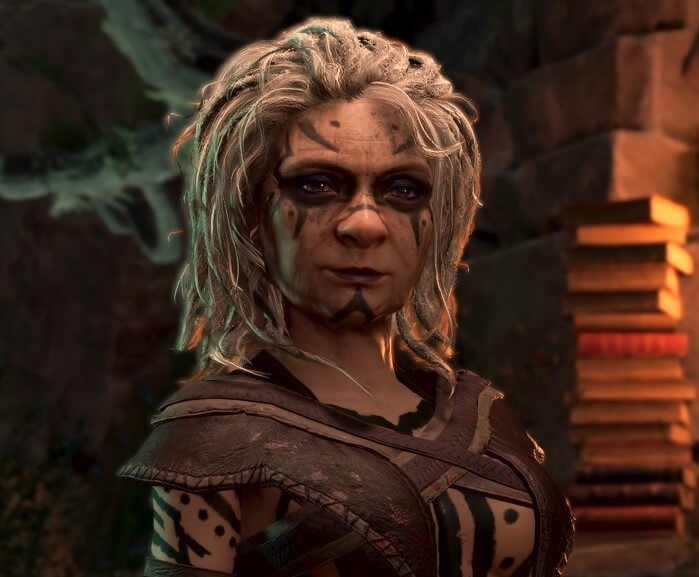
With just enough spell options as to not become overwhelmed like that of the other caster type classes, the Circle of the Land Druid is a go to for those just beginning to dabble in the realm of magic, while at the same time, making use of some fun shapeshifting options in occasional situations.
Find out where the Druid ranks in our Baldur’s Gate 3 class tier list.
Pros and Cons
Although the Circle of the Land Druid will not necessarily be the hero of the party, tanking enemies or doing huge bursts of damage like the Circle of the Moon Druid or an Evocation Wizard. They will, however, be the backbone of the group when it comes to making sure you have all the advantages you can in every situation.
With their ability to shapeshift, they can help speed up logistics and squeeze into small places or traverse over difficult terrain that may stop other party members in their tracks. They can also speak to animals and offer different dialogue options throughout the story.

During combat they will provide buffs to party members and be able to heal and cure certain conditions, using similar spells as a cleric, like Healing Word and Lesser Restoration.
They will also be able to crowd control enemies using spells like Entangle and Web, offering a great upper hand for your other spell casters in party, as well as using Thorn Whip to reel in foes closer for your melee specialists.
And, finally, what’s even more unique about Circle of the Land Druid is that since they are a spellcasting based Druid, and because they are in tune with the environment around them, they will gain access to spells that Circle of the Moon Druids will not have, and these spells will come already prepared, unlike other caster spells.
This means that depending on what terrain or biome you prefer, you can cast spells from that circle of magic that is connected to the type you choose and this provides you more spell options in addition to your prepared spells.
Pros
- High Utility with prepared Terrain/Biome-based spells
- Improved resource management with Natural Recovery
- Flexible Party Role (CC, Support, Heals, AoE Damage and more)
Cons
- Repetitive spell rotation in combat depending on role
- Less emphasis on Shapeshifting and fewer Wild Shape forms
- Not amazing at any specific thing
Races
The recommended race for this subclass is Gold Dwarf, Wood Elf or Wood Half-Elf, but I highly recommend Wood Elf, due to their superior base racial speed and their weapon proficiencies.

Being able to wield a shortbow or longbow, as well as the melee weapons that both Wood Elves and Druids are proficient in, is very helpful for extra damage or utility with magical arrows.
That being said, ideally, the goal is to create a character that can start with high Wisdom and Constitution.
As a rule of thumb, The goal is 16+ WIS, 16+ CON and at least 14 DEX.
The rest is not that important but should you want to equip medium armor at least 10 STR is what is required to wear it.
Background, and Skills
When it comes to Backgrounds, choose anything with proficiency in Wisdom based skills, like Animal Handling, Insight, Medicine, Perception, and Survival.
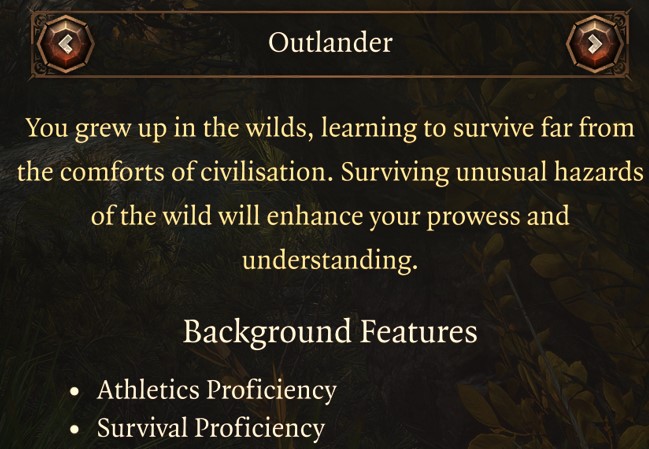
Acolyte, Folk Hero, and Outlander are the best at this time since they are Wisdom focused, but this may come down to your own specific preference and what background you prefer for your own playthrough.
Abilities and Spells
As far as spells and cantrips go, it is still preference based, and should be determined on how you want to play – but – you should consider your other party members and what classes, proficiencies and other spells they have since you will be playing a support role.
Level 1
Personally, at level 1, I would recommend Thorn Whip and Shillelagh for your first two cantrips, since Thorn Whip does damage and pulls enemies closer for your close melee ranged companions.
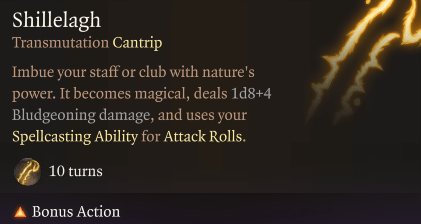
Shillelagh is nice to have at the beginning of the game since you won’t be wielding anything special, should an enemy get close to you during combat, but if you plan on being the main healer, or you do not have Guidance in your party, you should absolutely get Guidance instead.
Guidance is an amazing cantrip that is useful during and out of combat as it allows you to add advantage on dialogue rolls, which is huge when you are trying to roll on different Ability Score Checks, like Persuasion or Intimidation, etc.
In the area of spells, I recommend choosing Healing Word and Entangle as two of your four Learned Spells upon character creation since Healing Word does not require you to be in close range of your target like Cure Wounds, and it only counts as a bonus action. Meanwhile, Entangle is the first of many forms of crowd control you will have access to.
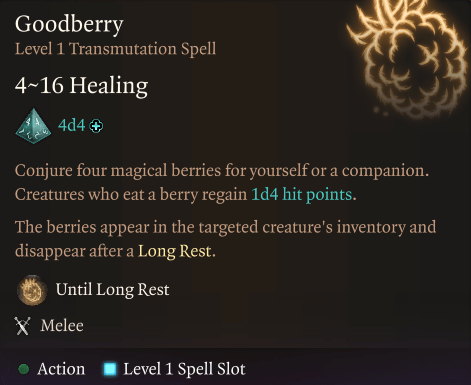
I would also look to add Goodberry for additional healing options other than just spells and potions, especially since they can sub in for camp supplies for a long rest.
Level 2
At level 2, you will choose your Druid Subclass – Circle of the Land – and gain another Cantrip & Spell of your choice.
You will also gain Natural Recovery at level 2, which provides you with a way to recover spell slots without having a long rest.
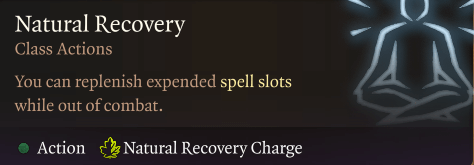
Level 3
When you get to level 3, as a Circle of the Land Druid, you will have access to level 2 Spells, and you will get to choose a preferred land type that will give you access to two level 2 Spells that are always prepared and do not take up spell slots.
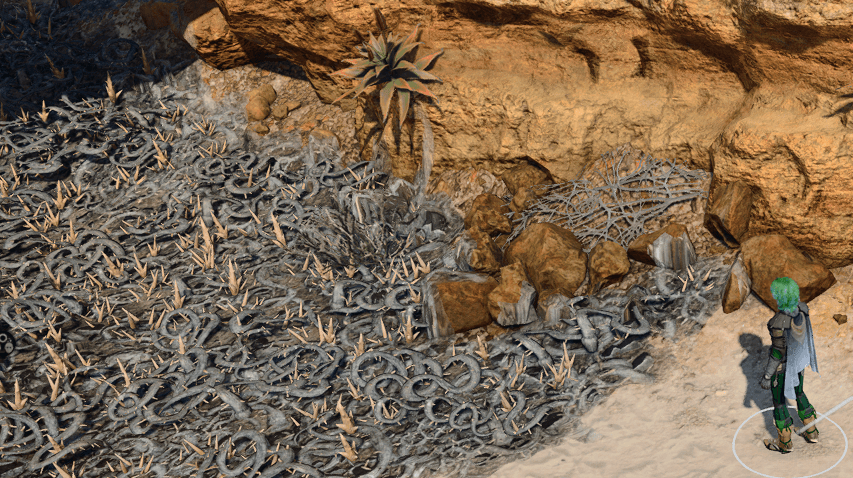
All of them are pretty interesting but as far as utility goes, Mountain and Underdark are the best, since Mountain grants you Spike Growth (which when cast and concentrated on is a very large area of thorns and overgrowth that cause enemies damage when they move through it) and Mirror Image (which brings forth three illusions of yourself and gives you a +9 to Armour Class and lasts for 10 turns, not costing any concentration).
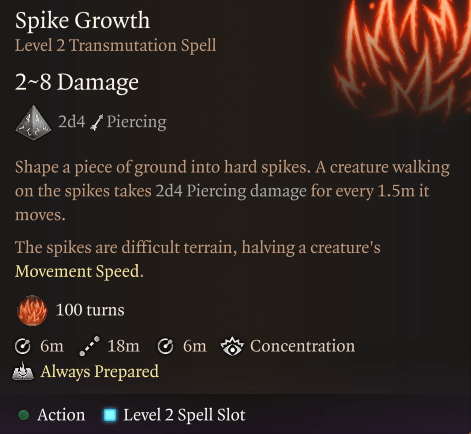
The Underdark terrain choice is more for the ability to still have a form of CC in the spell Web (which creates a targeted area effect that slows enemies) with the added bonus of always having Misty Step prepared, which allows you to teleport to an unoccupied space that you can see and it only counts as a bonus action.
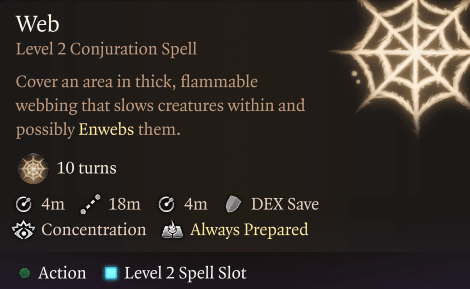
Additionally, at level 3, you will get an additional level 1 spell slot and two level 2 spell slots.
Prepare spells you love to use, or provide the most benefit to your party comp.
Level 4
Level 4 brings another cantrip and another level 2 Spell Slot (your preference – read them thoroughly and experiment) and an interesting new Wild Shape called Deep Rothe which can cast Dancing Lights, illuminating an area of darkness, and/or Charge, which provides a chance to drop enemies into a prone position.
Again, Shapeshifting is not entirely important but it could prove useful in some situations.
Also, at lLevel 4, you will choose your first Feat, and it is recommended that you take Ability Improvement. Use it to put two more points into Wisdom. Wisdom is your best friend.
Level 5
Level 5 brings with it another land type choice which gives you another two spells, that are level 3, to choose from, that are always prepared, and are related to the land chosen, as is the Circle of the Land Druid’s forte.
I would recommend Arctic or Mountain, but moving forward, check each of the terrains to see what spell options are available and fit into your playstyle.
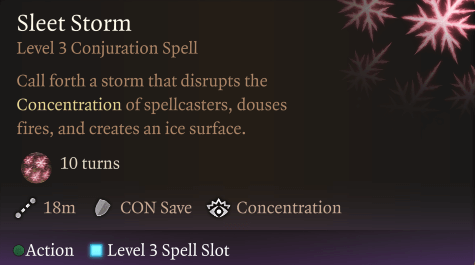
With Arctic at level 5, you will have Sleet Storm (which is great at breaking enemy Concentration and leaves a slippery terrain of ice to navigate) and Haste (which is a fantastic buff that is best placed on your multi-attacking classes, like a Berserker, granting them another action point for 10 turns).
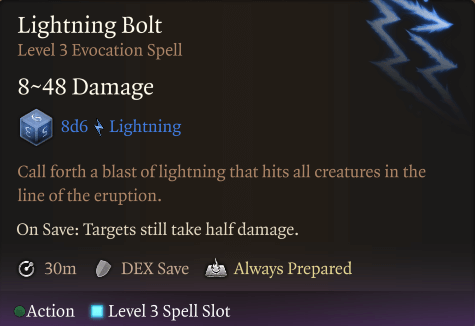
Compared to Mountain, you will instead gain Lightning Bolt (which is super high damage to multiple enemies if you can get in a good spot where they are lined up) and Grant Flight (which may be handy if you didn’t pick up Misty Step from Underdark earlier and/or don’t have an enchanted item that grants you Misty Step).
You will also have access to level 3 spells.
At level 6, the Circle of the Land Druid gets Land’s Stride, which gives the Druid a huge advantage with movement over difficult terrain, like plant overgrowth, swamps, etc. They also get an additional saving throw for magical plant-based CC.
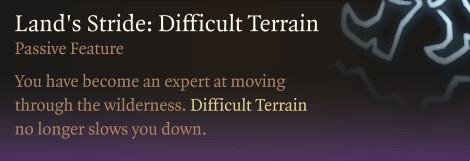
Each level thereafter offers more Spell Choices and eventually at lLevel 11 & 12 you will have access to one 6th level Spell slot.
Additionally, at level 7 & 9, you may choose another land type and, depending on what you choose, each of them will, again, have two unique prepared spells related to the land type chosen that are level 4 or 5 Spells, respectively depending on your character’s level (level 7 & 9).
The Circle of the Land Druid’s level 10 Class Feature is Nature’s Ward, which grants you a unique ability to be immune to Charm and Frighten (by elemental and fey) as well as becoming immune to disease and poison.
At the end of the day, you can always respec, so remember – the choice is yours, as all terrains offer certain types of spells and this is another way Baldur’s Gate 3 gives you the option to make use of many different spells and abilities for different situations.
Equipment
Since BG3 has just released, there is a lot of exploring to do, and there are a lot of amazing equipment choices, but for the most part, any weapon you are proficient in will do (even ranged weapons, since you will have decent DEX), but should you use a Club or a Quarterstaff, you can buff it using your Cantrip Shillelagh.
If you have 10 STR, then you can begin wearing Medium Armor right away, and the best Medium Armor to start with is Lae’zel’s Githyanki Half Plate or the Scale Mail that drops from Commander Zhalk
Githyanki Half Plate

Scale Mail
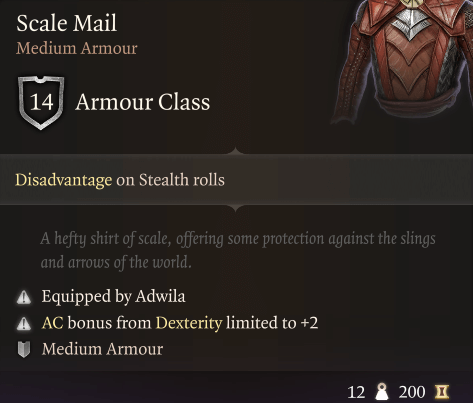
NOTE: When you shapeshift, AC/health is based on the specific Wild Shape you choose so bear that in mind when you make equipment choices.
Anything that benefits WIS based skills, or anything that helps your concentration during spellcasting is a great plus.
Keep an eye out for items that give a chance to earn back spell slots or grants buffs when healing a creature, or better yet, provides more healing to more than one target.
Also, save arrows! There are so many useful arrows and, as long as you are a Wood Elf, you can benefit from being proficient in Ranged Weapons, and these may prove very useful in longer combat situations when you run out of spell slots, which can happen more often than not in your early levels.
It’s best to begin with Clubs or Quarterstaves in ACT I, while saving any other weapons you may be proficient in – to give to your other melee companions, and since you will often be casting cantrips or concentrating on spells, you can use non-enchanted items until you find something better.
In my first playthrough I was able to get my hands on Melf’s First Staff, which is a decent staff with an Evocation Spell on it called Melf’s Acid Arrow, and an Arcane Enchantment that gives a +1 bonus to Spell Save DC and spell attack rolls.
Melf’s First Staff
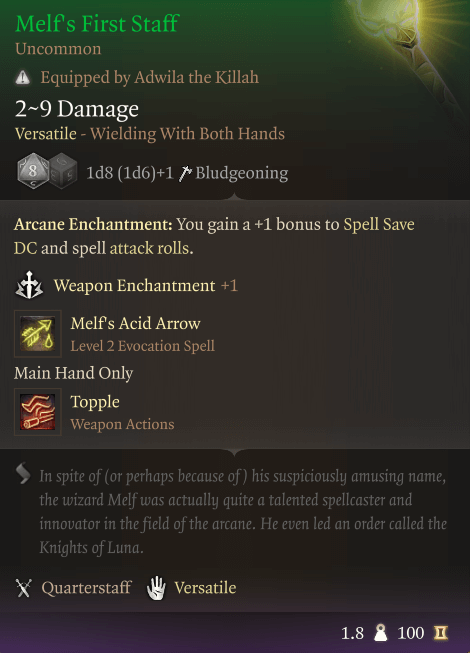
For a Ranged Weapon, I recommend either Spellthief or Bow of the Banshee. The latter still works even if you are not a Wood Elf.
Spellthief
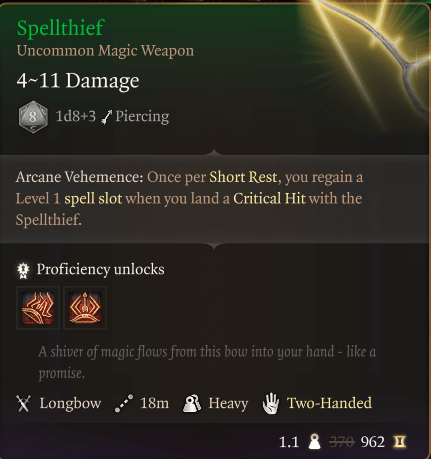
Bow of the Banshee
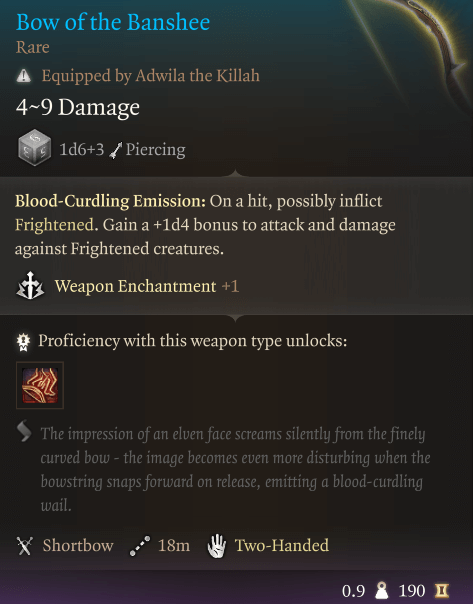
All arrows are good, so collect them all! Recommended are Arrow of Transposition or Arrow of Salving for situational moments and support.
Arrow of Transposition
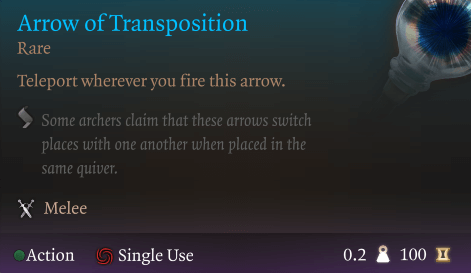
Arrow of Salving
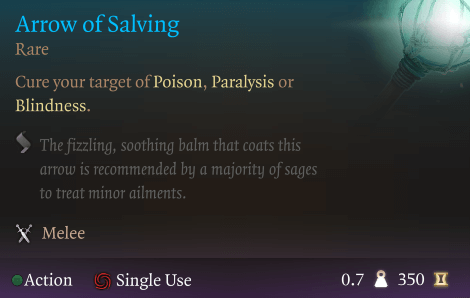
For other Act 1 accessories, I highly recommend the Amulet of Restoration in combination with the gloves Hellrider’s Pride, the ring called The Whispering Promise, and the Boots of Striding.
Wearing these together will trigger a bunch of buffs to you and your party when healing, especially when using Mass Healing Word, while also protecting you while you are concentrating on a spell like Spike Growth, for instance.
Amulet of Restoration
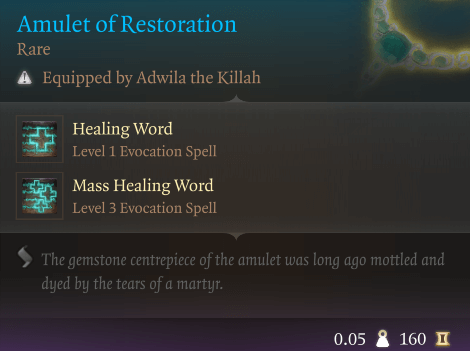
Hellrider’s Pride
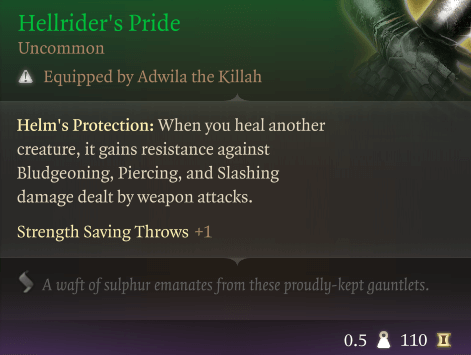
Whispering Promise
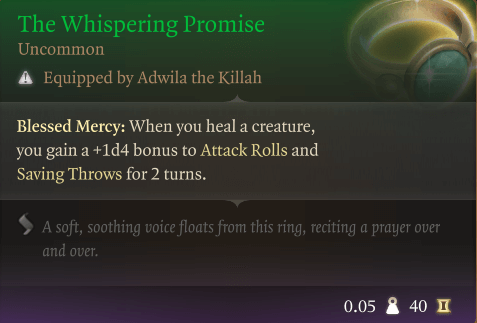
Boots of Striding
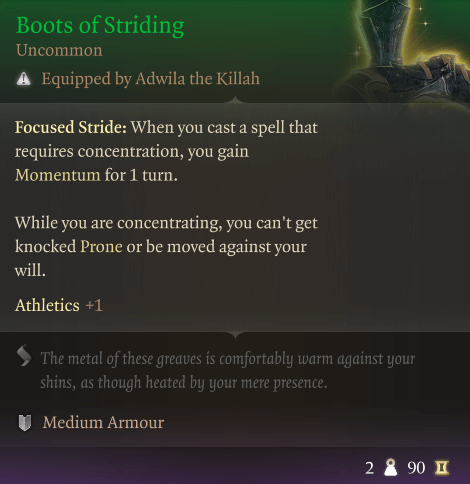
And when it comes to potions, oils and elixirs, I recommend you to keep a good selection of them on hand. You never know when they will come into use and, even if you won’t use them, your party will be grateful that you held onto them when they forget to keep an eye on how many of their favorite ones are in their inventory.
The most useful of all of them in ACT I, in my opinion though, are Potions of Flying and Potions of Greater Healing, as well as Elixirs of Arcane Cultivation, which grant you an extra spell slot of a varied level as shown below.
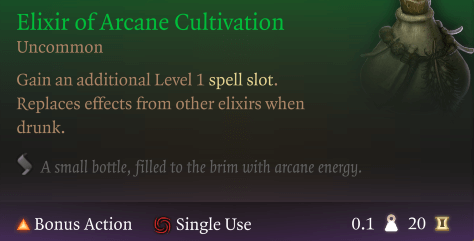
Elixir of Arcane Cultivation
Conclusion
Now, some may think the Circle of the Land Druid is a bit dull, but you can bet those people are not at peace with nature or the balance of life and death, and rightfully so, it takes a certain type to be at the helm of your party’s support role. It also takes some discipline and the will to be dependable and reliable in order to ensure the whole group’s success.
The Circle of the Land Druid is a very flexible subclass, and although you won’t be the best at any one thing, you are very resourceful and you will be able to read each situation during your journey and you will tend to have an answer for all situations, whether it be story or combat based.
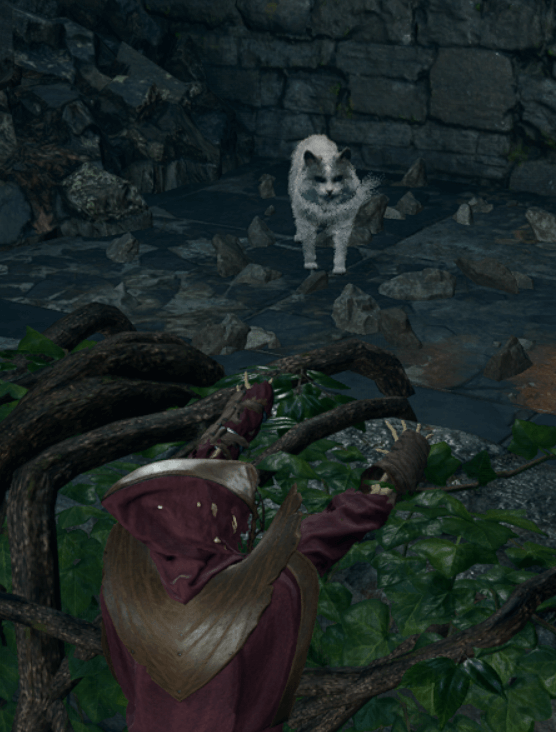
The ability to be so flexible will make you indispensable to your team and you will most likely earn some cheers and praise when you land those very critical heals and some very much-needed CC in the heat of the battle.
So, if you are the diligent type, and you want to feel needed – but don’t require the center of attention – this is the subclass for you. The added bonus? If you do get bored, you can always shapeshift and surprise an arachnophobe with your spider shape, or scout out areas of interest without drawing too much attention to your cat shape – but – you do know that curiosity killed the cat right? Be careful and have fun!
 Download APP
Download APP